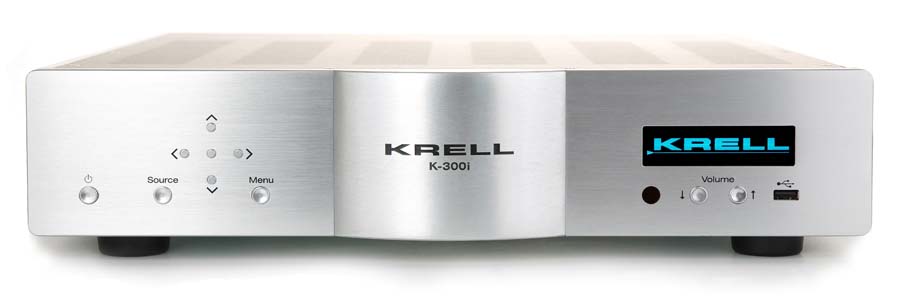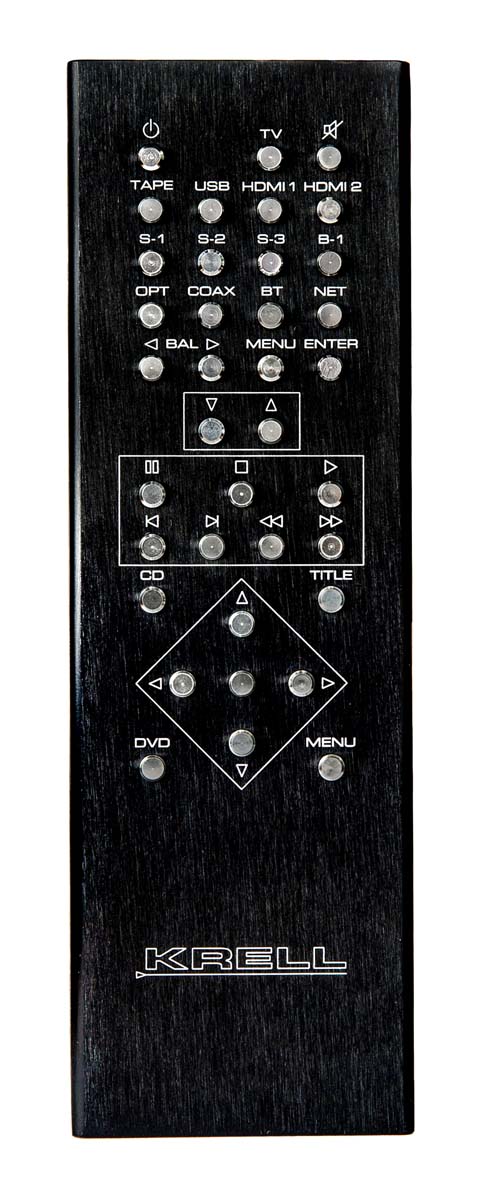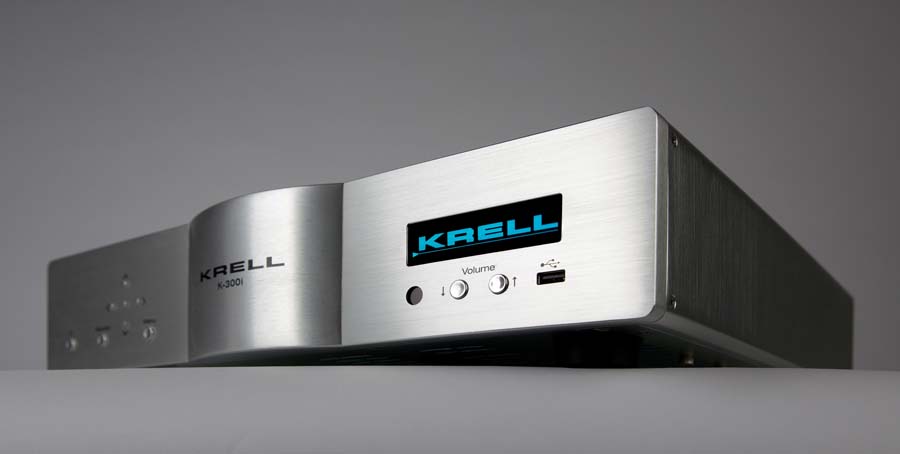American brand Krell is a name synonymous with big and powerful amplifiers. Here  Janine takes their £8998 (including digital board) K-300i Integrated, distributed in the UK by Absolute Sounds, and puts it through its paces.
Janine takes their £8998 (including digital board) K-300i Integrated, distributed in the UK by Absolute Sounds, and puts it through its paces.
I get excited when Krell bring out new products, having held a high opinion of the company and owned a few products in my life. My excitement wavered twice in recent years, first in 2009 when Dan D’Agostino left the Connecticut company and went to set up D’Agostino Master Audio Systems, and secondly when the heavyweight American construction was moved to China. That for me just wasn’t the Krell I knew. Dan’s ex-wife Rondi, who left at the same time as Dan, luckily rebought the company in 2016, and manufacture now is back in America with some exciting new products.
Krell began in 1980 with the KSA50 and then one of its best-ever products the KSA-100, both power amplifiers showing that transistors could sound as good and often better than valve. The first notable integrated was the KAV300i, making its triumphant entrance in 1999, headed by Dave Goodman. That amplifier is considered by many as the first integrated with the sound quality of a thoroughbred separate. The K-300i carries on the number “300” and is a development on the original model, and available as a purely analogue integrated amp or the digital version adding a significant choice of inputs, the latter up for review here. That option adds a further £1000 to the price tag of the analogue only model and coming in at a made-in-the-USA price of £8998. If it had been made in China no doubt it would be cheaper, but that just wouldn’t be a Krell. For the quality and finish, I wouldn’t expect anything cheaper. The model comes in a choice of black or silver finish and with the distinguishable Krell central front ‘bulge’ with a large “Krell K-330i” printed just in case you didn’t know what it was.
CONSTRUCTION
The K-330i is a beast of a beauty made of thick aluminium front and sides and weighing in at a hefty 23.6kg. The standard of finish and looks speak pure class, and being a Krell, one wouldn’t expect anything less than Class A. This usually means power-thirsty and hot monsters that are always sucking your expensive electricity whether or not it needs it, a reason why in recent years there has been a shift away from Class A in favour of economical Class D. However, what distinguishes this model over the previous generation, is the use of iBIAS. This process gives the benefits of Class A but without the power consumption and wasted heat of traditional Class A designs. It never gets hot. In simple terms, the circuit measures the output current of the amplifier and adjusts the bias to the optimum level. At low listening levels, the bias is reduced. But boy, this eco-class A amp is no less a beast. Offering 150W into 8Ω (300W into 4Ω) it employs a weighty 771VA transformer and 80,000µF of capacitance. Interestingly, the instruction manual warns against using AC regeneration or voltage conversion devices, as this may limit the power feeding the thirsty transformer and thus affect the sound quality. Luckily my home designed mains conditioner can take 20A so no worries there, although for the review I did some of the review without the conditioner just to check. Finally, the Krell employs Current Mode topology, with fully differential circuitry right from input to the output stage, ensuring an extremely linear and extended frequency response.
The basic analogue model has two XLR and 3 RCA inputs, plus an RCA pre-amp output in case you need it, and Krell’s 12VDC trigger input and output. The digital version adds a significant number of further possibilities and using the excellent ES9028PRO ESS Sabre Pro chipset. This is one hell of a versatile digital section. Options include a USB port at the rear and another at the front for your USB stick, a Bluetooth receiver with aptX (but not HD aptX, unfortunately), TosLink optical and S/PDIF Coax inputs, and an Ethernet input. It even has an HDMI 2.0a and HDCP2.2 input and a single HDMI output for those 4K audio-visual moments, plus RS232 control, baseband RC5 input. The circuitry can render MQA files and is a Roon end-point. The DAC allows DSD up to 128 and PCM up to 24/192 (optical up to 24/96). The digital module also works in conjunction with the downloadable Mconnect Control app on IOS and Android. The Mconnect Control app also handles network streaming audio from Spotify, Tidal, Deezer, Qobuz, and vTuner internet radio.
The front of the K-300i is sparse in comparison for the highly spec’d rear. All sockets and connectors are of excellent quality. The front panel contains the standby power button; the main on/off toggle is at the rear if your hands can get that far back if it sits in a shelf on your rack. I much prefer switches underneath the front. Indeed, it would have been ideal underneath the bulging front panel. Buttons at the back are just so hard to get to, and many people don’t leave electronics on standby all the time if they value the planet or their electricity bill. With the source button are 4 navigation buttons and a menu button. To the right of the bulging middle is the excellent display panel, volume up and down and the USB-A socket. Full access to the amplifier can, therefore, be made without the need for the gorgeous heavy black remote control. That remote has lots of small buttons on the top side, typical of Krell, and a distinctive heat-sink design underside, looking like a Class A remote, perhaps. I have always loved Krell remotes; they always look and feel expensive. The blue display on the K-300i initiates with the words Krell then allows you to select your source. Through the menu section, it allows you to individually name sources and even trim their levels. It even has provision to assign sources for the Theatre Mode. But it fails to indicate things I wanted to see, and there are 2 ½ lines of script space in order to do so. For example, playing my digital source into the Coax input it didn’t tell me whether I was playing FLAC or DSD, and bit rate etc. A shame. Bluetooth just said ‘PCM stereo’.
THE MUSIC
I, therefore, began using the digital inputs of the K-300i, starting with sources from my Fiio DAP. Oscar Peterson ‘Night Train’ (FLAC 24/192) was my first listen. Everything was there with each instrument well defined, but nothing stood out to me as being “wow” from this recording. I put that down to the amplifier coming straight out of the box, but as it warmed up (it doesn’t get hot like my resident Krell) the definition and placement of instruments became ever more profound. Next, I turned to the excellent Pat Metheny group and the album ‘The Way Up’. Performance was certainly way better through the amp; wide and precise drumming, particularly the ride cymbals, and guitarists playing up against each other as well as competing between the left and right speakers. The amplifier now sounded as good as I expected a Krell to be, even as good as a Krell separate. Turning to Miles Davies Quintet ‘Freedom Jazz Dance’ showed me just how much is in reserve in this “limited” 150W amplifier. 150W is ample. This double album, a copy of the master reel-to-reel tape from the recording studio, is really a rehearsal show for Miles and his musicians (including my favourite keyboardist Herbie Hancock), only rarely playing a piece from beginning to end, but you get the original tape recording complete with stops and starts mid-flow and interruptions from the sound engineer. It is well-engineered and actually quite engaging to listen to, and it really needs a good amp capable of coping with good fast transients and energetic bursts of sounds as well as quieter passages. This might be a baby Krell, but it was indeed a fully-fledged member of the family. The master tape must have been stored tail-in at times because print-through of sudden bursts of music is still audible before the real music begins. I always store my reel to reels tail-out so that any print-through from one layer of tape to the next happens just after the music starts, thereby hiding the sounds.
Turning to classics was the excellent Bach Toccata and Fugue BWV565 recorded by Mike Valentine (Chasing the Dragon 2). Perhaps not the best performance but excellently recorded using a spaced pair of Neumann valve microphones. The result was an equally excellent handling of both bass and treble. The bass was fully weighty when it needed to be, and top-end was clear and musical. Turning to the relaxing Ralph Vaughan Williams Symphony No 5 (EMI Bournemouth Symphony Orchestra) showed the amplifier could be gentle and sensible when it needed to be in this work full of relaxed contemplative segments as well as full-on horns, strings and percussion. Finally, on Bluetooth using my phone I played Bach Organ Concertos (Richard Egarr, The Academy of Ancient Music) the performance showed a new layer of detail for me; each instrument given its own space and time. The conductor has limited the strings to single instruments per part, much as Bach would have liked in his day. This was a live performance in my living room, and it sounded equally realistic when I went to the kitchen to make a cup of coffee; even in another room it sounded as if musicians were playing away in my house.
After using most digital inputs I moved to the analogue section, using balanced input from my Krell KPS20i CD player and also RCA from the excellent Manley Steelhead phono-stage and Ferrograph and Revox reel-to-reels. For the latter source I listened to the new reel to reel from Chasing the Dragon, which I recently reviewed, ‘A Day in the Life’ from Quentin Collins, featuring his “All Star Quintet” with him on a carbon Trumpet and flugelhorn. Having got accustomed to the sound on my home Krell KAV250a power amp, itself an excellent powerhouse, I wanted to hear how this £9000 entry-level Krell compared. When Quentin was charged with setting up a jazz band for this recording, he chose musicians he had worked with independently in the past, though this was the first time they played together as a quintet. What would be even more demanding is that they would only get a few hours to rehearse before an attempt at performing “as live” direct to vinyl, digital and tape masters. No time for mistakes then. The performance was notably better at the lower frequencies, the K300i having a solid bassline, with excellent clarity and speed making a very live performance of this as-live recording. What’s more, it tamed the music and the musicians; everything felt in the right place – the soundstage was improved on my own lowly Krell – and nothing felt too much effort. Quentin’s own composition “Modus Operandi” was well controlled and easy to get into the music. ‘Modus Operandi’ means a “particular way of doing something”, and whilst Krells can have a reputation of being distinctive in their sound, this one just performed as accurately as a £9000 amplifier should. It let the music take full reign. All was well controlled and tight. Whilst Dan might have moved on, Rondi seems to have brought things back under control with an amplifier that certainly warrants the iconic Krell logo on the front. This was for me a very important product for the company. Whilst part of me wanted a little more of the traditional Krell sound – a bit more punch and excitement – this amplifier was about accuracy and detail, and I soon got to appreciate just what Dave Goodman and his team were trying to do. Listening to David Gilmour ‘On an Island’, track 1, “Castellorizon” it allowed as much separation as an MC cartridge would allow, but in this and all the tracks in the album I felt the music perhaps didn’t have quite as much energy as I have heard from Krells of old, but the K-300i gave a well-controlled and accurate performance. Typical of David Gilmour (and the later Pink Floyd albums) track one sets the scene for the rest of the album. In ‘On an Island’ he packs in guitars, cello, violin, banjo, voices, fireworks and even an eastern brass instrument. They all sound great, but I wanted a little more oomph. That said, this integrated is definitely up with the best I have heard, and very hard to criticise. There was a vice-like grip on the music that made it cope with anything that was thrown at it, producing a very detailed and solid presentation. So much so that the “Krell” logo on the front should perhaps be twice the size as this amplifier deserved it. This certainly is a major product for the company.
CONCLUSION
This is an excellent amplifier, even as the baby of the Krell brigade, with excellent accuracy and dynamics no matter what I threw at it. What really sold it to me, though, was the digital board, not only the sound quality but also the facilities. I would, therefore, recommend going for the digital version of the K-300i, and whilst £9000 might seem a lot, you get on the Krell ladder with a really excellent machine.
AT A GLANCE
Build Quality: Excellent and solid construction, typical of Krell, including the distinctive thick front and side panels. Excellent components including large 771VA toroidal transformer.
Sound Quality: A very detailed and solid presentation ideal for those who don’t want to miss anything.
Value for Money: £8998 might seem a lot but this is masses of amplifier and digital board in one lovely box.
Pros: Vice like grip on all the music. Excellent bass end. Detailed and exciting presentation.
Cons: Just wish it wasn’t quite so deep (457mm), as can make it hard to connect new sources up at the back once it is in place in your rack.
Price: £8998 (including the £1000 digital board)

Janine Elliot
Review Equipment:
Pre-Audio GL-1102N/AT33sa turntable; Krell KPS20i (CD); Ferrograph Logic7 and Revox B77 (reel to reel); Graham Audio LS5/9 plus Townshend Supertweeter; homegrown mains conditioner, Townshend rack; Other cables used; Tellurium Q, Ecosse, Townshend and Nordost.
Specifications
|
















































































































































































































You must be logged in to leave a reply.